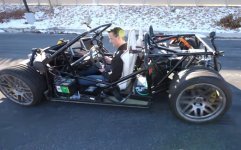Building a Tesla-like electric vehicle in your garage is an ambitious and complex project. It requires substantial knowledge in automotive mechanics, electrical engineering, and fabrication. Here's a high-level overview of the steps involved, including the key components and processes:
1. Research and Planning
Study Existing EVs: Understand the design and technology behind existing electric vehicles, especially Teslas. Look into their powertrain, battery management systems, and overall vehicle architecture.
Set a Budget: Building an electric vehicle (EV) can be expensive. Estimate costs for parts, tools, and any professional services you might need.
Legal Considerations: Ensure that your project complies with local laws and regulations regarding vehicle construction and modifications.

2. Sourcing Components
Electric Motor: Choose a powerful and efficient motor. AC induction motors and permanent magnet synchronous motors are common choices.
Battery Pack: Lithium-ion batteries are the standard for EVs due to their energy density and performance. You may source these from a supplier or repurpose used battery packs.
Battery Management System (BMS): This is critical for monitoring the battery's health, ensuring safety, and maximizing performance.
Controller/Inverter: This component manages the power flow between the battery and the motor, converting DC to AC if necessary.
Charger: You'll need an onboard charger compatible with your battery pack and the local electrical grid.
3. Design and Fabrication
Chassis: Either build a custom chassis or modify an existing one to accommodate the EV components. Ensure it is structurally sound and complies with safety standards.
Drivetrain: Design the drivetrain layout, including motor mounting, transmission (if used), and drive shafts.
Cooling System: Electric motors and batteries generate heat. A cooling system (liquid or air-cooled) is essential to maintain optimal operating temperatures.
Suspension and Brakes: Upgrade the suspension and braking systems to handle the added weight and performance of the EV components.
4. Electrical Integration
Wiring Harness: Design and install a wiring harness that connects all electrical components, ensuring proper insulation and routing.
Control Systems: Implement a control system for managing power distribution, regenerative braking, and other functionalities.
Instrumentation: Install a digital dashboard to monitor battery status, speed, temperature, and other critical parameters.
5. Assembly and Testing
Component Installation: Begin installing the major components, starting with the motor and battery pack, followed by the controller, BMS, and other electrical systems.
Initial Testing: Conduct static tests to ensure all systems are operational and there are no electrical faults.
Dynamic Testing: Perform low-speed tests to check for drivetrain alignment, braking efficiency, and steering responsiveness.
Performance Tuning: Fine-tune the controller settings and other parameters to optimize vehicle performance.
6. Safety and Certification
Safety Inspections: Have your vehicle inspected for safety compliance. This includes checking electrical insulation, structural integrity, and roadworthiness.
Certification: Depending on your location, you may need to get your vehicle certified for legal road use.
7. Documentation and Support
Keep Records: Document every step of your build, including part sources, wiring diagrams, and software configurations.
Community Support: Engage with online communities and forums for advice, troubleshooting, and support.
Resources for Guidance
Books and Manuals: Look for books like "Build Your Own Electric Vehicle" by Seth Leitman and Bob Brant.
Online Forums and Groups: Join forums like DIY Electric Car and Tesla Motors Club.
YouTube Channels: Channels like Rich Rebuilds and EV West provide valuable insights and tutorials.
Conclusion
Building a Tesla-like EV in your garage is a challenging but rewarding project that requires careful planning, technical knowledge, and perseverance. By following the steps outlined and utilizing available resources, you can undertake this ambitious project and create a custom electric vehicle.
1. Research and Planning
Study Existing EVs: Understand the design and technology behind existing electric vehicles, especially Teslas. Look into their powertrain, battery management systems, and overall vehicle architecture.
Set a Budget: Building an electric vehicle (EV) can be expensive. Estimate costs for parts, tools, and any professional services you might need.
Legal Considerations: Ensure that your project complies with local laws and regulations regarding vehicle construction and modifications.

2. Sourcing Components
Electric Motor: Choose a powerful and efficient motor. AC induction motors and permanent magnet synchronous motors are common choices.
Battery Pack: Lithium-ion batteries are the standard for EVs due to their energy density and performance. You may source these from a supplier or repurpose used battery packs.
Battery Management System (BMS): This is critical for monitoring the battery's health, ensuring safety, and maximizing performance.
Controller/Inverter: This component manages the power flow between the battery and the motor, converting DC to AC if necessary.
Charger: You'll need an onboard charger compatible with your battery pack and the local electrical grid.
3. Design and Fabrication
Chassis: Either build a custom chassis or modify an existing one to accommodate the EV components. Ensure it is structurally sound and complies with safety standards.
Drivetrain: Design the drivetrain layout, including motor mounting, transmission (if used), and drive shafts.
Cooling System: Electric motors and batteries generate heat. A cooling system (liquid or air-cooled) is essential to maintain optimal operating temperatures.
Suspension and Brakes: Upgrade the suspension and braking systems to handle the added weight and performance of the EV components.
4. Electrical Integration
Wiring Harness: Design and install a wiring harness that connects all electrical components, ensuring proper insulation and routing.
Control Systems: Implement a control system for managing power distribution, regenerative braking, and other functionalities.
Instrumentation: Install a digital dashboard to monitor battery status, speed, temperature, and other critical parameters.
5. Assembly and Testing
Component Installation: Begin installing the major components, starting with the motor and battery pack, followed by the controller, BMS, and other electrical systems.
Initial Testing: Conduct static tests to ensure all systems are operational and there are no electrical faults.
Dynamic Testing: Perform low-speed tests to check for drivetrain alignment, braking efficiency, and steering responsiveness.
Performance Tuning: Fine-tune the controller settings and other parameters to optimize vehicle performance.
6. Safety and Certification
Safety Inspections: Have your vehicle inspected for safety compliance. This includes checking electrical insulation, structural integrity, and roadworthiness.
Certification: Depending on your location, you may need to get your vehicle certified for legal road use.
7. Documentation and Support
Keep Records: Document every step of your build, including part sources, wiring diagrams, and software configurations.
Community Support: Engage with online communities and forums for advice, troubleshooting, and support.
Resources for Guidance
Books and Manuals: Look for books like "Build Your Own Electric Vehicle" by Seth Leitman and Bob Brant.
Online Forums and Groups: Join forums like DIY Electric Car and Tesla Motors Club.
YouTube Channels: Channels like Rich Rebuilds and EV West provide valuable insights and tutorials.
Conclusion
Building a Tesla-like EV in your garage is a challenging but rewarding project that requires careful planning, technical knowledge, and perseverance. By following the steps outlined and utilizing available resources, you can undertake this ambitious project and create a custom electric vehicle.
